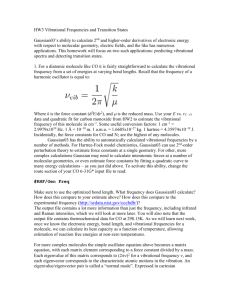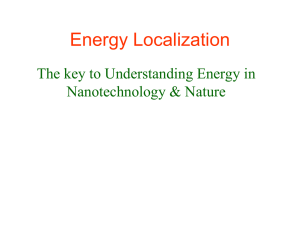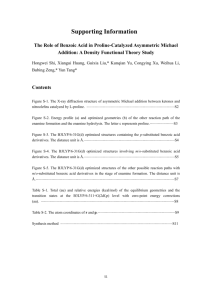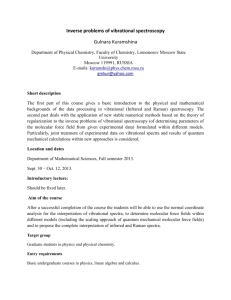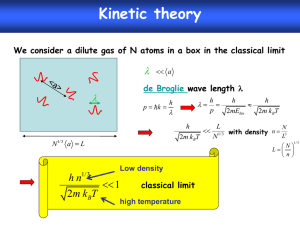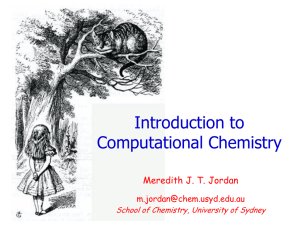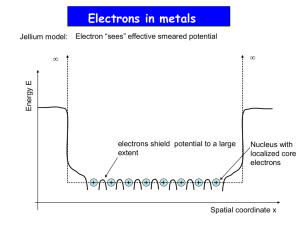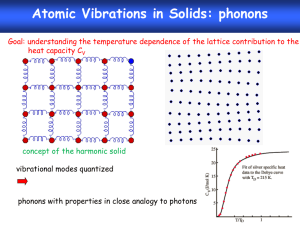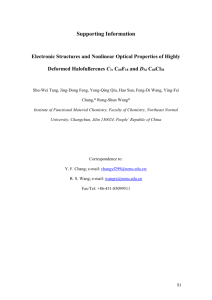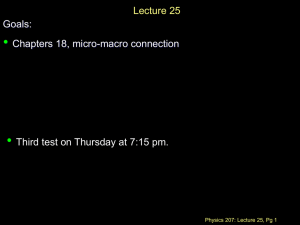Word Document
advertisement
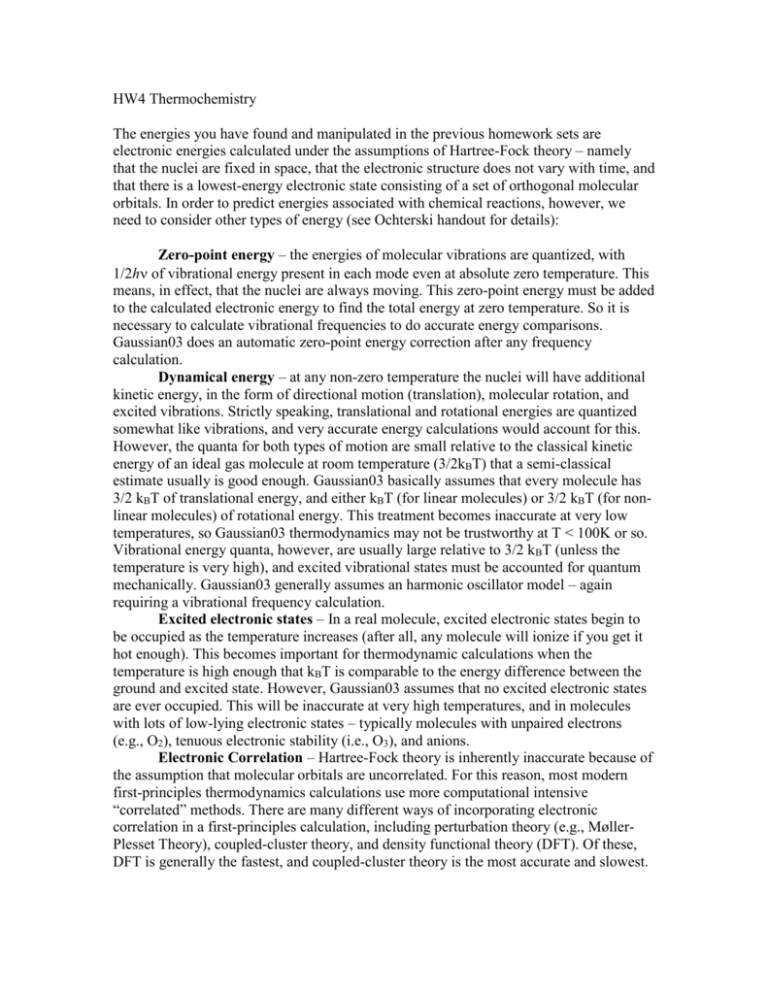
HW4 Thermochemistry The energies you have found and manipulated in the previous homework sets are electronic energies calculated under the assumptions of Hartree-Fock theory – namely that the nuclei are fixed in space, that the electronic structure does not vary with time, and that there is a lowest-energy electronic state consisting of a set of orthogonal molecular orbitals. In order to predict energies associated with chemical reactions, however, we need to consider other types of energy (see Ochterski handout for details): Zero-point energy – the energies of molecular vibrations are quantized, with 1/2h of vibrational energy present in each mode even at absolute zero temperature. This means, in effect, that the nuclei are always moving. This zero-point energy must be added to the calculated electronic energy to find the total energy at zero temperature. So it is necessary to calculate vibrational frequencies to do accurate energy comparisons. Gaussian03 does an automatic zero-point energy correction after any frequency calculation. Dynamical energy – at any non-zero temperature the nuclei will have additional kinetic energy, in the form of directional motion (translation), molecular rotation, and excited vibrations. Strictly speaking, translational and rotational energies are quantized somewhat like vibrations, and very accurate energy calculations would account for this. However, the quanta for both types of motion are small relative to the classical kinetic energy of an ideal gas molecule at room temperature (3/2kBT) that a semi-classical estimate usually is good enough. Gaussian03 basically assumes that every molecule has 3/2 kBT of translational energy, and either kBT (for linear molecules) or 3/2 kBT (for nonlinear molecules) of rotational energy. This treatment becomes inaccurate at very low temperatures, so Gaussian03 thermodynamics may not be trustworthy at T < 100K or so. Vibrational energy quanta, however, are usually large relative to 3/2 kBT (unless the temperature is very high), and excited vibrational states must be accounted for quantum mechanically. Gaussian03 generally assumes an harmonic oscillator model – again requiring a vibrational frequency calculation. Excited electronic states – In a real molecule, excited electronic states begin to be occupied as the temperature increases (after all, any molecule will ionize if you get it hot enough). This becomes important for thermodynamic calculations when the temperature is high enough that kBT is comparable to the energy difference between the ground and excited state. However, Gaussian03 assumes that no excited electronic states are ever occupied. This will be inaccurate at very high temperatures, and in molecules with lots of low-lying electronic states – typically molecules with unpaired electrons (e.g., O2), tenuous electronic stability (i.e., O3), and anions. Electronic Correlation – Hartree-Fock theory is inherently inaccurate because of the assumption that molecular orbitals are uncorrelated. For this reason, most modern first-principles thermodynamics calculations use more computational intensive “correlated” methods. There are many different ways of incorporating electronic correlation in a first-principles calculation, including perturbation theory (e.g., MøllerPlesset Theory), coupled-cluster theory, and density functional theory (DFT). Of these, DFT is generally the fastest, and coupled-cluster theory is the most accurate and slowest. 1. By default, Gaussian03 calculates thermodynamic properties at the standard temperature (298.15K). Calculate kBT at this temperature, and convert to Kcal/mol (NAkB = R, the gas constant). Compare this to the rotational and translational energies in your CO2 and H2O vibrational frequency output. 2. Methanogenesis is thought to be one of the more primitive metabolic strategies for early life, and is still used by bacteria in anaerobic environments: CO2 + 4H2 CH4 + 2H2O Calculate the enthalpy and Gibbs free energy of this reaction at 298.15 K and 1 bar, at the RHF/6-31G* level (you’ve already got most of the data you need from the last homework). The experimental enthalpy for this reaction is roughly –39.4 ±~1 KCal/mol (I think – feel free to double check my numbers at the NIST chemistry web book). How does your calculation compare? Thermochemistry is one of the most demanding applications of first-principles geochemistry, because we need accurate total energies. Structure and vibrational frequency calculations depend on small perturbations of the energy, so lots of errors get canceled out. Typically, thermochemistry calculations use post-Hartree-Fock methods and large basis sets. Most common is a mixture of Hartree-Fock and Density Functional Theory developed by Becke (1993, Journal of Chemical Physics v. 98, p. 5648), called B3LYP (Becke’s optimized 3-component mix of Hartree-Fock with Lee, Yang, and Parr’s Density Functional). B3LYP was actually optimized to reproduce the thermochemistry of many of the same molecules Scott and Radom (1996) studied to calculate vibrational frequency scale factors – it is not strictly a first-principles method. Density functional theory in Gaussian03 is integrated over a discrete spacial grid. Recalculate the enthalpy of the methanogenesis reaction using the B3LYP model. You can do this by substituting B3LYP for RHF in the route section: #B3LYP/6-31G* Opt Freq To improve the numerical accuracy of the result, you can try tightening the criteria Gaussian03 uses to optimize the molecular structures and find self-consistent solutions to Schrödinger’s equation, and making the spacial grid finer: #B3LYP/6-31G* Opt=Tight SCF=Tight Integral(Ultrafine) Freq To avoid tedium, you may want to check these numerical options on one or two molecules – if the electronic energy difference is < 0.2 Kcal/mol, it won’t affect the ultimate accuracy by much. Finally, try a larger basis set, like 6-311+G(2df,2p). This basis set is similar to the 6311G* basis you’ve been using, but has an extra, broad Gaussian s or p-type basis function, two d basis functions and one f basis function for each non-Hydrogen atom, and two extra p basis functions on each Hydrogen atom. Feel free to try an even bigger basis set, if you like. 3. Estimate the enthalpy of formation of the simple organic molecule formaldehyde (CH2O, a C2v structure) from CO and H2. Is this reaction exothermic or endothermic at 298.15 K, 1 atm? As far as I can tell, experiments (combustion calorimetry) are ambiguous on this issue.
